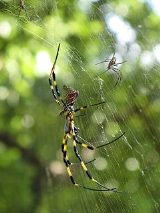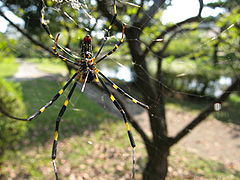
Nephila clavata
Encyclopedia
Nephila clavata, also known as the , is a member of the golden orb-web spider group. The spider can be found throughout Japan
except Hokkaidō
, in Korea
, Taiwan
and China
. Due to the large size as well as the bright, unique colors of the species of the female Nephila, the spider is well-favored in Japan.
 Nephila clavata pass winter as eggs and scatter as tiny juveniles in the spring. The female's body size is 17–25 mm, while the male's is 7–10 mm.
Nephila clavata pass winter as eggs and scatter as tiny juveniles in the spring. The female's body size is 17–25 mm, while the male's is 7–10 mm.
The web of female Nephila can reach one meter in width; the yellow threads appear rich gold in sunlight. The structure of the web seen in cross section is unusual for an orb web; it has 3 layers: the central orb, plus 2 irregular layers in front and behind the orb.
The adult female individual has stripes of yellow and dark blue, with red towards the rear of the abdomen. In autumn, smaller male(s) may be seen in the female's web for copulating. After mating the female spins an egg sack on a tree, laying 400 - 1500 eggs in one sack. The life cycle ends by late autumn or early winter.
is a legendary creature in Japanese folklore
. A Jorōgumo is a spider which can change its appearance into that of a beautiful woman. She attracts men, and once a man has been trapped as a result of her seduction, he will be tied up and eaten by her.
Japan
Japan is an island nation in East Asia. Located in the Pacific Ocean, it lies to the east of the Sea of Japan, China, North Korea, South Korea and Russia, stretching from the Sea of Okhotsk in the north to the East China Sea and Taiwan in the south...
except Hokkaidō
Hokkaido
, formerly known as Ezo, Yezo, Yeso, or Yesso, is Japan's second largest island; it is also the largest and northernmost of Japan's 47 prefectural-level subdivisions. The Tsugaru Strait separates Hokkaido from Honshu, although the two islands are connected by the underwater railway Seikan Tunnel...
, in Korea
Korea
Korea ) is an East Asian geographic region that is currently divided into two separate sovereign states — North Korea and South Korea. Located on the Korean Peninsula, Korea is bordered by the People's Republic of China to the northwest, Russia to the northeast, and is separated from Japan to the...
, Taiwan
Taiwan
Taiwan , also known, especially in the past, as Formosa , is the largest island of the same-named island group of East Asia in the western Pacific Ocean and located off the southeastern coast of mainland China. The island forms over 99% of the current territory of the Republic of China following...
and China
China
Chinese civilization may refer to:* China for more general discussion of the country.* Chinese culture* Greater China, the transnational community of ethnic Chinese.* History of China* Sinosphere, the area historically affected by Chinese culture...
. Due to the large size as well as the bright, unique colors of the species of the female Nephila, the spider is well-favored in Japan.
Characteristics

The web of female Nephila can reach one meter in width; the yellow threads appear rich gold in sunlight. The structure of the web seen in cross section is unusual for an orb web; it has 3 layers: the central orb, plus 2 irregular layers in front and behind the orb.
The adult female individual has stripes of yellow and dark blue, with red towards the rear of the abdomen. In autumn, smaller male(s) may be seen in the female's web for copulating. After mating the female spins an egg sack on a tree, laying 400 - 1500 eggs in one sack. The life cycle ends by late autumn or early winter.
Silk
Researchers, led by Masao Nakagaki, at Shinshu University, Japan have succeeded in creating a silk thread that is stronger, softer and more durable than conventional silk by injecting silkworm eggs with genes of the spider. The silkworms that hatch weave cocoons containing 10% spider protein. The dragline silk is said to have many uses, such as: bulletproof vests, sutures after an operation, tennis rackets, fishing line, and nets. A Japanese manufacturer named Okamoto had begun developing commercial applications for the spider silk, and planned to release extra-thin, durable spider socks by year 2010. A Dutch school in Nijmegen has been doing advanced experiments with these spider's webs of which the results are to be announced early June 2011.Nephila clavata in folklore
JorōgumoJorogumo
Jorōgumo is a type of Yōkai, a creature, ghost or goblin of Japanese folklore. According to some stories, a Jorōgumo is a spider that can change its appearance into that of a seductive woman....
is a legendary creature in Japanese folklore
Japanese folklore
The folklore of Japan is heavily influenced by both Shinto and Buddhism, the two primary religions in the country. It often involves humorous or bizarre characters and situations and also includes an assortment of supernatural beings, such as bodhisattva, kami , yōkai , yūrei ,...
. A Jorōgumo is a spider which can change its appearance into that of a beautiful woman. She attracts men, and once a man has been trapped as a result of her seduction, he will be tied up and eaten by her.

